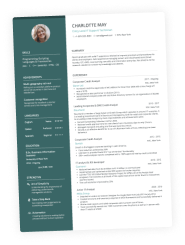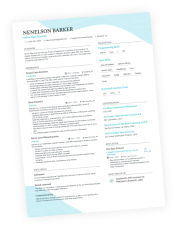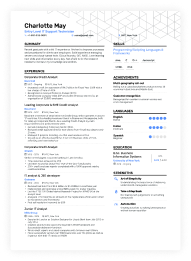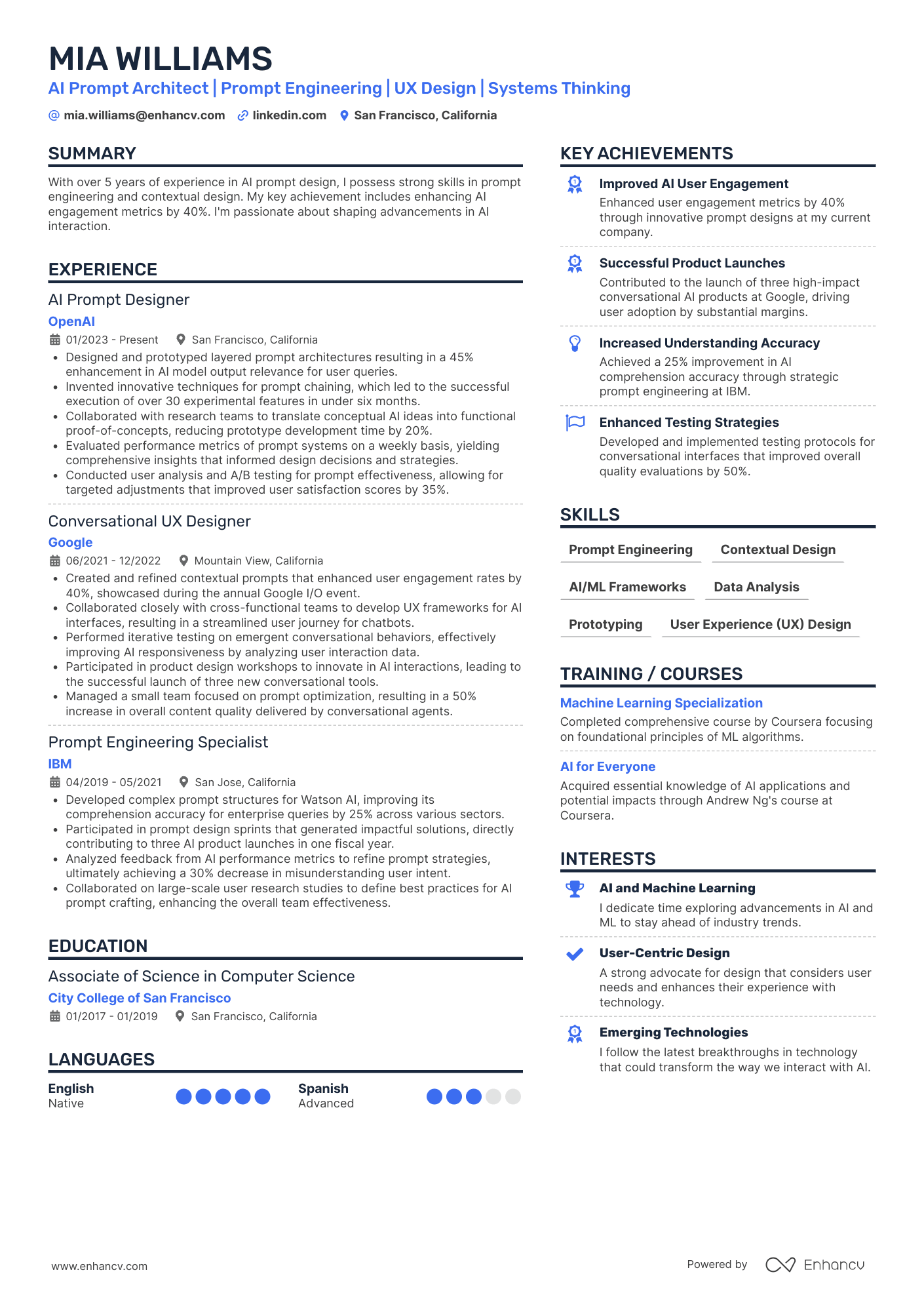The job market is, to put it mildly, more crowded than ever. Hiring managers often spend just a few moments skimming through each resume. Crafting one that stands out can be an incredibly difficult task.
However, with the right approach, you can write a resume that’s hard to ignore. Keep in mind, standing out doesn’t mean stuffing your document with buzzwords and flashy fonts. It means showing your personality, passion for the role, and the unique value you can bring to the employer.
In this guide, our team of resume experts reaches deep into our collective bag of tricks to present you with practical and creative strategies to make your resume the star of the show.
Key takeaways
- Don’t forget the basics—stick to format, design, and layout best practices.
- Tailor your resume to each role to show employers exactly what they’re looking for.
- Tell a compelling career story to convey your personality and passion for the job.
- Consider using a personal branding statement instead of the traditional summary.
- Prove your impact with real examples, results, or successful projects.
What do employers look for in a resume?
Nowadays, recruiters are more selective than ever. This means your application needs to check the essential boxes if you want to land a few job interviews.
A standout resume covers the following basics:
Tailored content
Hiring managers can spot generic, one-size-fits-all resumes at a glance. What they truly want to see is clear evidence you understand the role and have the necessary experience and skills for the job. The best way to achieve this is with a targeted resume, using keywords and terminology that match the job description.
Measurable impact
Listing job duties won’t get you anywhere. Instead, give your resume credibility through quantifiable achievements. Make it even more compelling by using action verbs and offering examples of specific results.
Easy to read
Employers appreciate clean, easy-to-scan resumes that put the most important information up front. Good formatting, clear headings, and the right keywords not only help human readers but also ensure your resume gets past applicant tracking systems (ATS).
Hold on. We hear you:
“But Enhancv, don’t all serious candidates send out resumes that are tailored, credible, visually pleasing, and ATS-friendly?”
Sure, they do. Let’s see if we can take your resume enhancement even further.
How to make your resume stand out to employers
If you want to distinguish yourself from a torrent of lookalike applications, your resume should convey that you’re not just qualified but memorable.
Let’s take a look at some actionable strategies that'll make hiring managers pause and say, “Hold on, we need to meet this person.”
1. Use a personal branding statement
A typical resume summary often sounds like a bland list of skills or vague descriptors.
For example:
Weak summary writing
“Results-oriented professional with excellent communication skills and a proven track record.”
The problem? Most applicants, especially those who’ll make their resume with AI, will end up with a summary like this—one that lacks character and fades into the background.
On the other hand, a personal branding statement makes things a lot more interesting. It’s bold, defines what makes you unique, and highlights what specific value you bring to the employer.
Instead of listing soft skills, it combines your key strengths, core expertise, and a hint of your personality.
Here’s one:
Strong personal branding statement
“Tech-savvy project manager who builds cross-functional teams that deliver complex products ahead of schedule.”
This is memorable and sets you apart. Think of it as your elevator pitch on paper: concise, clear, and tailored for the roles you want.
2. Use storytelling elements to craft your career narrative
Most resumes are just lists of jobs and bullet points. On the other hand, a resume that reads like a compelling story instantly makes an impression.
This approach makes your career trajectory feel intentional and helps hiring managers see you as a real person with a clear sense of direction—not just somebody in need of employment.
Start thinking of your resume as a short, professional narrative.
Use your summary section to set the scene:
- Who are you?
- What drives you
- What unique perspective do you bring?
Example:
Continue this story-driven presentation in your work experience section by framing your achievements as mini anecdotes, each with its own challenge, action, and result.
Example:
- •Led a full Salesforce implementation that integrated sales, marketing, and customer service teams—resulting in a 25% faster sales cycle within the first year.
- •Collaborated with end-users to identify daily pain points, designing custom workflows and dashboards that improved data accuracy and user adoption.
- •Trained and supported a team of 50+ staff members, helping them feel confident and capable with new tools and processes.
- •Acted as the bridge between technical teams and non-technical stakeholders, ensuring everyone stayed aligned and solutions stayed human-focused.
PRO TIP
What makes storytelling powerful is that it’s persuasive. Recruiters love to see evidence that a candidate can tackle real-world problems and deliver results. These short success stories instantly make you more credible and memorable—they show exactly how you create value.
3. Include a mini case study or project highlight with results
Pick one or two notable initiatives from your experience and put them in a dedicated projects section in your resume so they can be noticed.
In just a line or two, explain the challenge you faced, what actions you took, and the measurable outcome you achieved.
You can…
Use the STAR method
STAR stands for Situation, Task, Action, and Result. It’s an effective framework for giving strong answers to interview questions or writing resume bullet points.
Here’s a breakdown:
- What was the context? (Situation)
- What was your responsibility? (Task)
- What actions did you take? (Action)
- What did you achieve? (Result).
The STAR method helps you tell clear, compelling stories that show your impact.
For example:
“Led a cross-team initiative to streamline onboarding, reducing ramp-up time by 40% and saving the company $50,000 annually.”
4. Insert a short testimonial from a manager or client
Short, authentic testimonials from managers, colleagues, or clients give recruiters a glimpse of how others see your work and your character.
You don’t need a whole paragraph. One or two sentences that address your strengths or impact are enough. It’s a personal touch that shows you’re someone people value and trust.
It’s best to place them at the bottom of your resume but if things are getting too crowded in your document, then simply put them in your cover letter.
For example:
5. Include a link to an interactive element
Adding a portfolio, a website, or a video to your resume—one you personally developed—is another effective way to make an impression. This way, employers will see your technical skills and personality come to life beyond what your resume offers.
This works especially well for creative fields, marketing roles, tech, or any job where presenting your work visually gives you an edge.
PRO TIP
Make sure the link is easy to spot and access—you can add it near your contact info or personal branding statement. Surely it'll go great with one of our creative resume templates.
6. Show how your personality and passions align with the role
Another great strategy to make your resume feel genuine and memorable is to connect who you are outside of work with what you do professionally. This subtle connection helps you stand out as someone who truly lives and breathes the kind of work you’re applying for.
What you can do is add a short section at the end of your resume—titled “Professional Interests.” Then write a line or two about how your interests make you an even better fit for the job.
Example:
PRO TIP
Remember, instead of just listing hobbies for the sake of it, pick interests and side projects that naturally tie back to the skills, values, or mindset the role requires. If you’re unable to do that, then it’s best to avoid putting a personal interests section on your resume. It’ll only take up valuable space and distract the reader.
7. Use a splash of color or a unique layout
Most resumes look the same—black and white, plain fonts, standard templates. How about showing some personal style?
Adding a subtle accent color or a unique but professional layout can make yours stand out visually.
Stick to one or two accent colors on your resume that match your industry and personal brand. Use them on headings, lines, or icons to guide the reader’s eye.
A fresh layout—like a two-column resume—can also break up text and make your information easier to scan.
We used Enhancv’s AI-powered Resume Builder to create this example:
PRO TIP
Remember, readability comes first. An over-designed resume can be distracting. Always test your design, both on a screen and printed, to make sure it helps your chances. It’d be great if you could get some feedback from a visually-savvy friend or colleague you trust.
As someone with over a decade of experience in hiring decisions, I’ve seen a lot of resumes. If I had to describe the ones that really stood out to me, I’d say something along the lines of “polished and stacked but humble and down-to-earth.”
I’ve always been thankful to open a resume file and see a clean, refined look. Imagine my elation when I actually start to read it and realize the candidate is truly qualified for the job. Yet, they’re not boasting or exaggerating their accomplishments.
They’re simply stating what they achieved and letting the results and numbers speak for themselves. Those are the candidates I wanted to meet.
Author’s take
How to make your resume stand out with no experience
When you’re just starting on your career journey, writing a resume with little to no professional experience can feel intimidating. Still, it’s absolutely possible to make yours feel special and full of potential.
The secret is to focus on your transferable skills and any practical experience you do have, even if it didn’t come from a traditional job. In this case, a functional resume format is the perfect approach.
A functional resume focuses on your skills and strengths rather than your work history. Instead of listing jobs, you’re supposed to group your experience by skill areas or themes relevant to the role you’re applying for.
This format is often used by candidates with gaps in their employment history or those who are transitioning from one career to another.
Here’s what to focus on:
Stand out with a functional resume
| What to focus on | How to put it into practice |
|---|---|
| Transferable skills | Have an expanded skills section that details how you brought value in your previous roles. |
| Non-full-time work | Part-time jobs, internships, volunteer work—any practical experience counts, especially if it shows responsibility, initiative, or leadership. |
| Projects section with relevant work | Building an app, designing a website, running a social media campaign, even organizing an event—these are all viable options to detail in a “no experience” resume. |
| Certifications and online courses | Add any completed courses, workshops, or professional certifications related to the job or industry. |
| Academic initiatives | You can list relevant coursework, research, or major projects that relate directly to the job. |
| Extracurricular activities and leadership roles | Clubs, student organizations, sports teams, or community involvement can complement your skill set. |
When you don’t have direct experience, your goal is to prove that you have the passion, potential, and willingness to learn. Employers have a thing for motivated candidates. And one of the best ways to express your motivation—and complement your resume—is to write a cover letter.
A cover letter is a one-page document you send with your resume. Its purpose is to formally introduce yourself to the employer.
However, its strategic value in the application process lies in allowing you to connect with hiring decision-makers on a personal level by showing your personality and telling a compelling story.
How to make your resume stand out for an internship
Companies love interns who show enthusiasm, initiative, and a bit of personality. However, landing an internship is just as competitive as getting a full-time job.
The key to building an internship resume is to come across as someone who will bring fresh ideas, positive energy, and be genuinely committed to the role.
Here’s what you can do:
Strategies to build an internship-winning resume
| What to focus on | How to put it into practice |
|---|---|
| Lead with a clear statement of intent | Unlike a boring objective, write one or two lines that show you understand what the company does. Say why you want to intern there specifically, and state how you can contribute to their goals. |
| Include a “Why this company?” line | Add a bullet or mini blurb saying what connects you to the company. Mention a project, value, or recent news that supports this idea. |
| Show your curiosity and initiative | Include any self-initiated learning—online courses, independent research, or hobby projects relevant to the role. |
| Highlight teamwork and communication early | With many internships, collaboration is more valued than hard skills alone. Give clear examples of times you’ve worked well in teams, led a group, or resolved real-world issues. |
| Add a “Campus Impact” section | Don’t just list clubs—show how you made a difference. For example, “Organized a charity hackathon that raised $5,000 for local schools.” |
| Include a mini pitch for your fresh perspective | Show that you can bring new ideas. For example: “As a Gen Zuser, I offer insights on what engages young audiences on social media platforms.” |
| Showcase micro-experiences | Got any short gigs, side hustles, freelance work, or campus ambassador roles? Describe what you did, the skills you used, and the results. |
| Add a unique interest that sparks conversation | A quirky, authentic hobby can make your resume memorable and help you connect in interviews. For example: “Running a newsletter on local food trucks with 1,000+ subscribers.” |
| Signal that you’re eager to learn | A line that shows your growth mindset can tip the scales: “Excited to learn from industry mentors and contribute fresh ideas to real projects.” |
Conclusion
Whether you’re an experienced professional, someone in between jobs, or a student looking to intern at “a cool company,” there’s so much you can do to make your resume memorable. Yes, there’s some rough competition out there, but you can outplay most of them with the right strategy and presentation.
Make one that's truly you.




